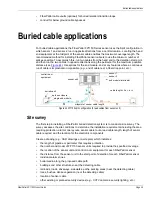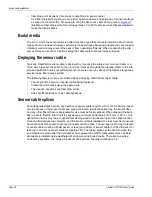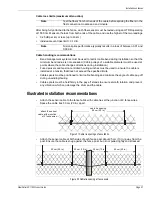
Installation on fences
FiberPatrol FP1150 Product Guide
Page 51
FiberPatrol sensor cable and below ground bypasses
FiberPatrol sensor cable typically passes through conduit that is buried below ground to get from
one side of a gate to the other. There are several techniques that can be used to pull the cable
through conduit. The best method to use depends on a number of site specific factors:
•
the local climate, if the site has a temperate climate and the ground never freezes, split conduit
can be used to protect the sensor cable
•
in areas where ground freezing occurs, solid wall conduit must be used; the solid conduit must
be sealed at both ends to prevent water from entering
•
if the cable is being deployed from a cable stand, the cable can be pulled through the conduit
as it is dispensed
•
if the cable is being deployed from a trailer or truck, it will have to be pulled back to pass
through the conduit
•
a sufficient amount of cable must be pulled back for isolation loops, service loops, and gate
coverage, as required
FiberPatrol installation
1.
Ensure that there is enough sensor cable in the equipment room to reach the fiber connection
module in the equipment rack and to make a 10 m service loop.
2.
Run the sensor cable to the designated start point of the detecting cable.
3.
If the site plan calls for a splice at the designated start point, ensure that there is enough cable
to reach the splice enclosure on the fence, plus enough to make a 10 m service loop, and if
required, a 13 m isolation loop (optional) then cut the cable.
OR
3.
If the site plan calls for a continuous run of cable at the designated start point, leave enough
cable to make a 13 m isolation loop (optional) and continue to deploy the sensor cable around
the perimeter.
Figure 59 Solid wall conduit






























